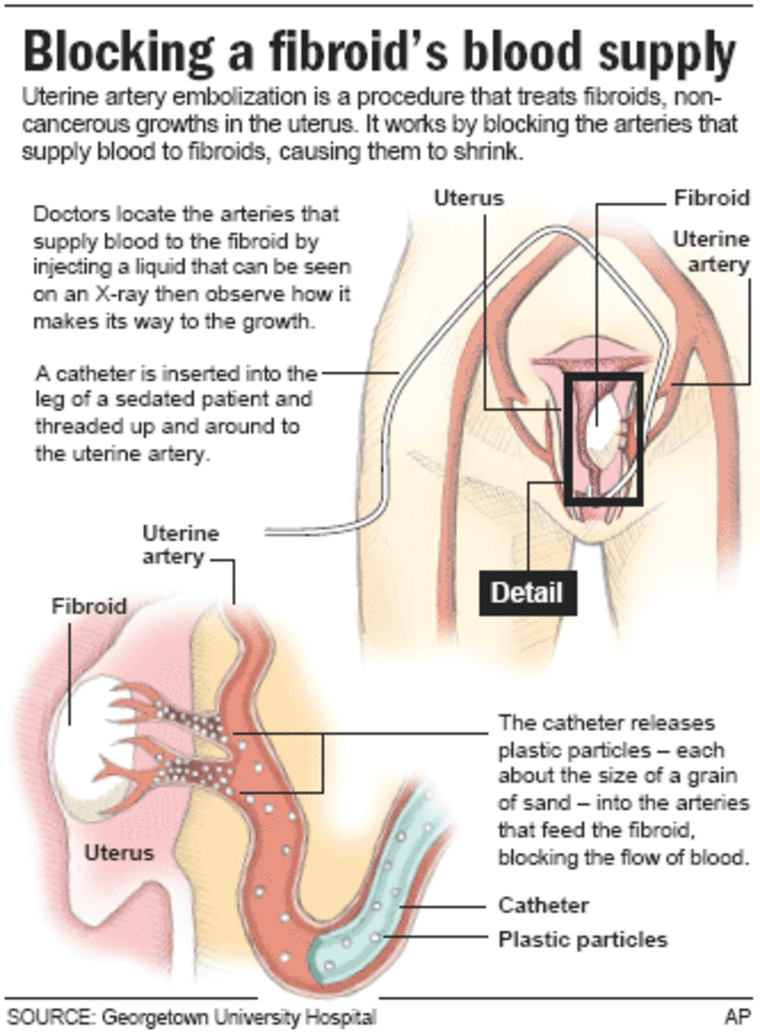Women who had less invasive treatment for painful uterine fibroids did about as well as those who had surgery, including hysterectomy, suggests a new study that lays out the options for a troubling condition affecting millions of women.
Uterine fibroids are common among women of child-bearing age. Nearly 40 percent develop these noncancerous growths in the uterus that often don’t cause any symptoms. While the most common treatment is surgery to remove tumors that cause extreme pain, some women choose a gentler procedure that allows them to keep their uterus.
However, the study found there were some trade-offs to the popular procedure known as uterine artery embolization. While embolization patients spent far less time in the hospital, they also were more likely to need a repeat treatment.
Although the study did not address whether embolization can preserve fertility, it adds to growing evidence that this less drastic approach is a safe alternative to hysterectomy.
“For some women, retaining a uterus is much more important than avoiding repeat surgery, particularly for younger women,” said Dr. James Spies, a Georgetown University radiologist who had no role in the new research. Spies successfully treated Condoleezza Rice, who was then U.S. national security adviser, with fibroid embolization in 2004.
Fibroids are noncancerous growths of muscle fibers inside the uterus that can range from a quarter inch in size to as large as a cantaloupe. In serious cases, uterine fibroids can cause heavy menstrual bleeding, pelvic soreness and pain during sex.
For decades, hysterectomy — removal of the uterus — was the only option. Of the roughly 600,000 hysterectomies performed yearly in the United States, about a third are due to fibroids.

Since the 1990s, the popularity of uterine artery embolization has steadily grown. An estimated 13,000 to 14,000 embolizations are done each year in the U.S., according to the Society of Interventional Radiology.
The American College of Obstetricians and Gynecologists says that while embolization is an option for women with fibroids, there’s not enough evidence to show that it’s safe for women who want to get pregnant.
The procedure involves making a small nick in the groin and inserting a catheter in the artery. Using real-time imaging, doctors then blast tiny pellets into the uterine artery to cut off the blood supply that feeds the fibroids. Over time, these tumors shrink and die.
Patients typically stay overnight in the hospital and are usually sedated or under local anesthesia during the procedure. Embolization, which is covered by most major insurers, tends to be cheaper than surgery at the outset. The costs even out during follow-up care, according to various estimates.
The new study published in Thursday’s New England Journal of Medicine randomly assigned 106 women to embolization and 51 to surgery. The patients were in 27 hospitals across the United Kingdom. Most in the surgery group had hysterectomies while a few had myomectomies, surgical removal of the fibroids while leaving the uterus intact. Many women can get pregnant after having a myomectomy, but there’s a chance the fibroids might return.
Both groups of patients rated pain levels, mental health and recovery process among other factors. After a year of follow-up, researchers found no significant difference in the quality of life for either group.
However, the embolization group recovered faster, with the median hospital stay one day, compared with five days in the surgery group.
Despite the faster recovery, 13 percent in the embolization group were re-admitted to the hospital after a year, including 10 percent who needed a repeat procedure or hysterectomy because of recurrent symptoms.
“The results of our study make clear that the choice between surgery and uterine artery embolization ... involves trade-offs,” wrote lead author Richard Edwards of Gartnavel Hospital in Glasgow, Scotland.
The study had some limitations. The hysterectomies performed involved making large incisions in the body that prolonged recovery time. Advanced medicine now allows surgeons to make small cuts during the operation, allowing for faster recuperation.
The study’s re-treatment rate was higher than statistics kept by a U.S. national registry.
The ideal candidate for embolization is a woman who does not plan to get pregnant and whose symptoms make it risky for her to have surgery, said Dr. Michael Miller, a Duke University radiologist who has performed over 200 embolizations.
Since the safety of embolization and pregnancy is still unknown, the first “line of treatment” for women who plan to have children should be myomectomy, Dr. Togas Tulandi, a professor of obstetrics and gynecology at McGill University in Canada, wrote in an editorial accompanying the study.